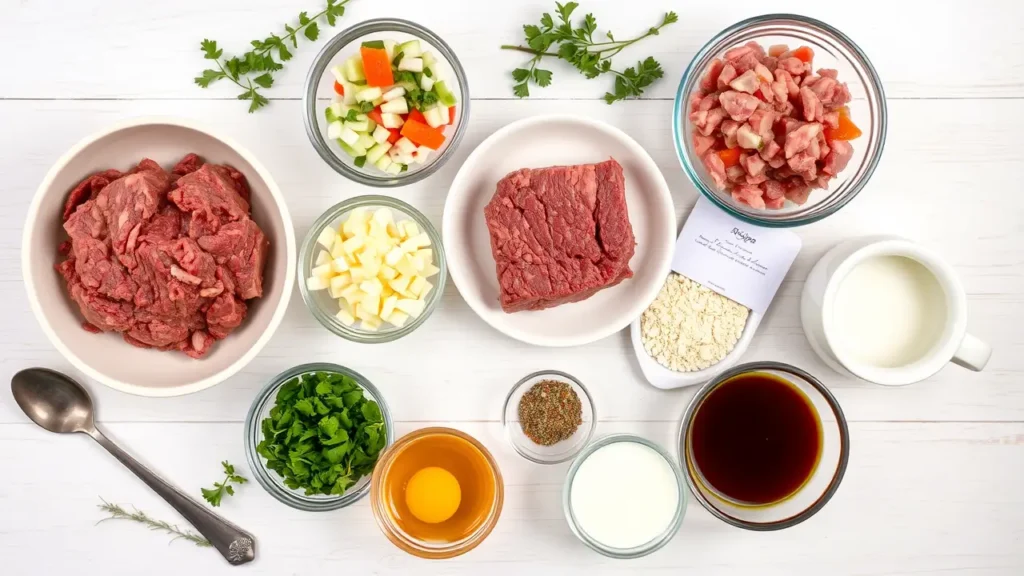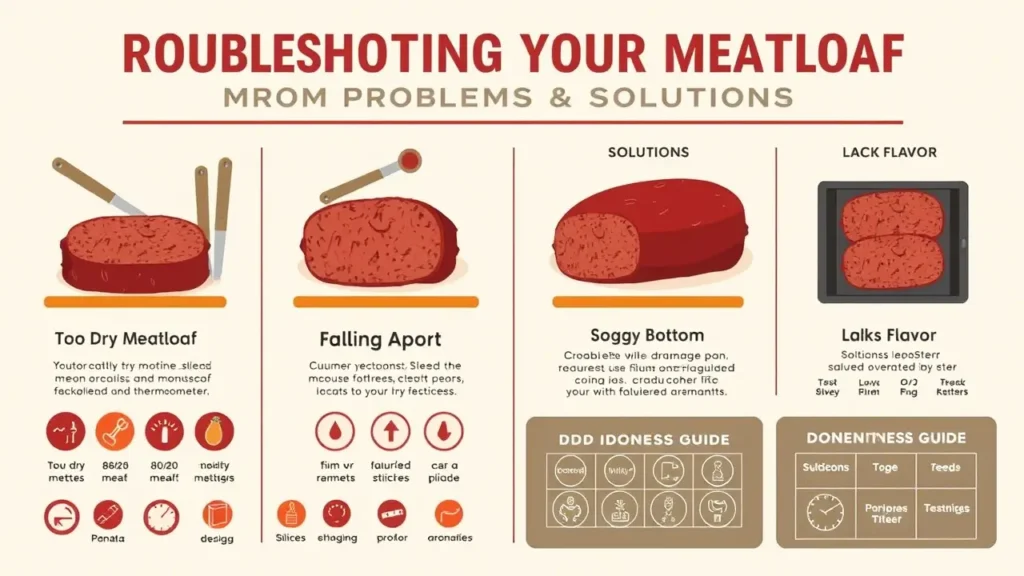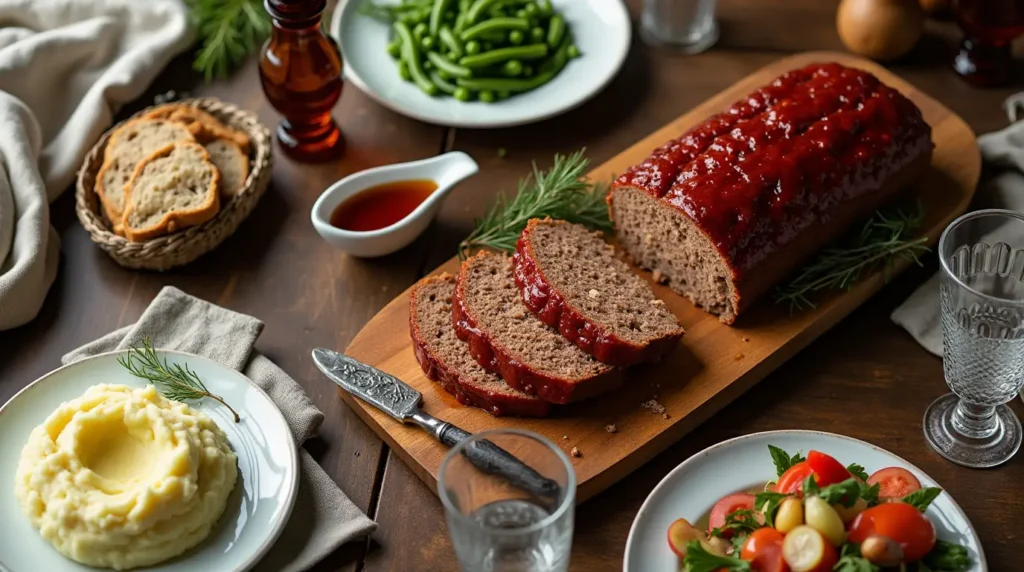
My grandmother’s kitchen always smelled like paradise on Sunday afternoons. The rich, savory aroma of her beef loaf recipe would waft through the house, drawing everyone to the table before she even called us for dinner. I can still picture her hands—weathered from decades of cooking for our family—gently mixing the ingredients in her favorite blue ceramic bowl. That homemade meatloaf recipe wasn’t just food; it was love, tradition, and comfort all wrapped up in one humble dish. Years later, when I found myself alone in my first apartment, homesick and overwhelmed, it was Grandma’s beef loaf recipe that I reached for. As the familiar scent filled my tiny kitchen, I felt connected to home despite being hundreds of miles away. That’s the magic of a good meatloaf—it’s more than just dinner; it’s a warm embrace on a plate.
This quintessential American comfort food has graced dinner tables for generations, evolving from a simple way to stretch ingredients during tough times to a beloved family favorite worthy of both weeknight dinners and special occasions. Whether you’re searching for the best meatloaf recipe to add to your repertoire or looking to perfect your existing technique, this guide will walk you through everything you need to know about creating the perfect beef loaf recipe every time.

The History and Evolution of Beef Loaf
The humble meatloaf has a surprisingly rich history that spans centuries and continents. While many of us associate the classic meatloaf recipe with 1950s American kitchens, the concept of mixing ground meat with other ingredients dates back to Ancient Rome, where cooks would combine minced meat with bread crumbs, wine, and spices before baking.
The modern beef loaf recipe as we know it began taking shape in the United States during the Great Depression. As families struggled to make ends meet, creative home cooks found that adding breadcrumbs, oats, and vegetables to ground beef could stretch this precious protein to feed more mouths. What started as an economic necessity evolved into a beloved comfort food that has stood the test of time.
By the 1950s, meatloaf had secured its place as an iconic American dish. The rise of convenient, processed foods during this era brought innovations like adding canned soups or ketchup-based glazes to simple meatloaf recipes, creating the familiar versions many of us grew up with.
Today’s beef loaf recipes continue to evolve, with chefs and home cooks alike experimenting with global flavors, premium ingredients, and innovative techniques while still honoring the dish’s humble roots.
Regional Variations Across America
Like many beloved American dishes, beef loaf recipes vary widely depending on the region:
- Southern-style: Often includes a sweet glaze made with brown sugar and incorporates finely diced bell peppers and onions
- Midwestern: Typically features a more straightforward approach with minimal ingredients and often uses oats instead of breadcrumbs
- New England: Frequently includes a mix of ground beef, pork, and veal for a more complex flavor profile
- Southwestern: Incorporates spices like cumin and chili powder, sometimes with additions like corn and black beans

Key Ingredients for the Perfect Beef Loaf
Creating the best meatloaf recipe starts with understanding the role each ingredient plays in building flavor and texture. Let’s break down the essential components of a stellar beef loaf recipe:
The Meat Blend
While a simple meatloaf recipe can be made with just ground beef, many cooks swear by using a blend of meats for the most flavorful result:
- Ground beef: The foundation of most beef loaf recipes, ideally with a fat content of 80/20 (lean/fat) for moisture and flavor
- Ground pork: Adds richness and a subtle sweetness
- Ground veal: Contributes tenderness and a delicate flavor (optional)
For the best meatloaf recipe results, avoid extra-lean ground beef, as the fat is crucial for maintaining moisture and flavor during the long cooking process.
Binding Agents and Fillers
These ingredients help hold your beef loaf recipe together while adding texture and stretching the meat:
- Breadcrumbs: Traditional choice that creates a tender texture
- Rolled oats: Provides a heartier texture and nutritional boost
- Crackers: Saltines or Ritz crackers can add flavor and binding
- Eggs: Essential for binding the meat mixture together
Flavor Boosters
These ingredients transform a basic beef loaf recipe into a memorable meal:
- Aromatics: Onions, garlic, carrots, and celery create a flavor foundation
- Herbs: Parsley, thyme, and oregano add freshness
- Condiments: Worcestershire sauce, mustard, and tomato products add depth
- Seasonings: Salt, pepper, paprika, and other spices customize the flavor profile
The Glaze
No tender meatloaf recipe is complete without a delicious topping:
- Classic: Ketchup, brown sugar, and vinegar create the tangy-sweet glaze many remember from childhood
- Barbecue: Store-bought or homemade barbecue sauce offers smoky depth
- Savory: Gravy or mushroom sauce provides rich, umami flavor

The Ultimate Classic Beef Loaf Recipe
Now that we understand the building blocks, let’s put them together to create the best meatloaf recipe that delivers consistent results every time. This classic meatloaf recipe strikes the perfect balance between traditional flavors and modern techniques for a memorable meal.
Ingredients
For the meatloaf:
- 2 pounds ground beef (80/20 lean-to-fat ratio)
- 1/2 pound ground pork (optional)
- 1 large onion, finely diced
- 2 carrots, finely diced
- 2 celery stalks, finely diced
- 3 garlic cloves, minced
- 1/4 cup fresh parsley, chopped
- 2 large eggs, lightly beaten
- 3/4 cup breadcrumbs
- 1/3 cup milk
- 2 tablespoons Worcestershire sauce
- 1 tablespoon Dijon mustard
- 1 teaspoon dried thyme
- 1 1/2 teaspoons salt
- 1/2 teaspoon black pepper
- 1/4 teaspoon paprika
For the glaze:
- 1/2 cup ketchup
- 2 tablespoons brown sugar
- 1 tablespoon apple cider vinegar
- 1/2 teaspoon garlic powder
- 1/4 teaspoon onion powder
Instructions
- Prepare your workspace: Preheat your oven to 350°F (175°C). Line a baking sheet with foil or parchment paper, or lightly grease a 9×5-inch loaf pan.
- Sauté the aromatics: Heat a tablespoon of olive oil in a skillet over medium heat. Add the onions, carrots, and celery with a pinch of salt and cook until softened, about 5-7 minutes. Add the garlic and cook for another 30 seconds until fragrant. Allow the mixture to cool slightly.
- Create the panade: In a large bowl, combine the breadcrumbs and milk. Let sit for 5 minutes until the breadcrumbs absorb the milk. This creates a panade—a crucial step for a tender meatloaf recipe.
- Mix the ingredients: To the bowl with the panade, add the cooled vegetable mixture, ground beef, ground pork (if using), eggs, Worcestershire sauce, Dijon mustard, parsley, thyme, salt, pepper, and paprika. Mix gently with your hands until just combined. Avoid overmixing, which can make your beef loaf recipe tough.
- Shape the loaf: Transfer the mixture to your prepared baking sheet and shape into a loaf approximately 9 inches long and 4-5 inches wide. If using a loaf pan, press the mixture into the pan.
- Prepare the glaze: In a small bowl, whisk together all glaze ingredients until smooth.
- Apply the glaze: Spread half of the glaze over the meatloaf before baking.
- Bake: Cook the meatloaf for 40 minutes, then spread the remaining glaze on top. Continue baking for another 15-20 minutes, or until an instant-read thermometer inserted into the center registers 160°F (71°C).
- Rest: Allow the meatloaf to rest for 10 minutes before slicing. This helps the juices redistribute for the most tender meatloaf recipe result.
Why This Recipe Works
This classic meatloaf recipe succeeds because it balances several key elements:
- The panade (bread and milk mixture) keeps the texture moist
- Pre-cooking the vegetables removes excess moisture and deepens flavor
- The meat blend provides the perfect fat content for juiciness
- Two-stage glazing creates a caramelized, flavorful crust
| Common Meatloaf Problem | Solution in This Recipe |
|---|---|
| Dry texture | Panade and proper meat ratio |
| Falls apart when sliced | Proper binding with eggs and breadcrumbs |
| Bland flavor | Pre-cooked aromatics and layered seasonings |
| Soggy bottom | Baking on a sheet instead of in a loaf pan |
| Too dense | Gentle mixing technique |
Creative Variations on the Traditional Beef Loaf
While the classic meatloaf recipe holds a special place in our hearts, don’t be afraid to experiment with these innovative twists that transform the humble beef loaf recipe into something extraordinary:
Italian-Inspired Beef Loaf
Transform your homemade meatloaf recipe into a taste of Italy with these modifications:
- Replace breadcrumbs with Italian-seasoned varieties
- Add 1/2 cup grated Parmesan cheese
- Include 2 tablespoons Italian seasoning
- Stuff the center with mozzarella cheese for a melty surprise
- Top with marinara sauce instead of traditional glaze
- Serve with garlic bread and a simple green salad
Bacon-Wrapped Wonder
Take your beef loaf recipe to the next level by wrapping it in bacon:
- Lay bacon strips on a work surface, slightly overlapping
- Place your prepared meatloaf mixture on top
- Wrap the bacon up and around the meatloaf
- Brush with a maple-mustard glaze for a sweet-savory finish
- Bake as directed, adding time if needed to crisp the bacon
Mini Meatloaf Muffins
Perfect for portion control and faster cooking, this adaptation of the simple meatloaf recipe is ideal for busy weeknights:
- Prepare the meatloaf mixture as usual
- Divide between a 12-cup muffin tin
- Create a small indent in each and fill with a teaspoon of glaze
- Bake at 350°F for just 20-25 minutes
- Excellent for meal prep and freezing individual portions
Global Flavor Profiles
Reinvent your beef loaf recipe with worldwide flavors:
Mexican Inspired:
- Add 1 diced jalapeño, 1 tablespoon cumin, and 1 teaspoon chili powder
- Mix in 1/2 cup corn and 1/4 cup chopped cilantro
- Top with salsa instead of traditional glaze
- Serve with avocado slices and lime wedges
Greek Style:
- Incorporate 1/2 cup crumbled feta cheese and 1/4 cup chopped Kalamata olives
- Add 2 teaspoons dried oregano and 1 teaspoon dried mint
- Serve with tzatziki sauce on the side
Asian Fusion:
- Replace Worcestershire with soy sauce and add 1 tablespoon grated ginger
- Mix in 1/4 cup chopped water chestnuts for crunch
- Glaze with a mixture of hoisin sauce, honey, and sriracha
- Garnish with sliced green onions and sesame seeds

Tips for Troubleshooting Common Beef Loaf Problems
Even experienced cooks sometimes encounter challenges when making a beef loaf recipe. Here are solutions to the most common issues:
When Your Meatloaf Is Too Dry
The most frequent complaint about meatloaf is dryness. Fix this problem with these adjustments to your homemade meatloaf recipe:
- Use meat with higher fat content (80/20 is ideal)
- Add more binding ingredients like eggs or breadcrumbs soaked in milk
- Consider adding grated vegetables like zucchini or carrots for natural moisture
- Don’t overcook—use a meat thermometer to pull it from the oven at exactly 160°F
- Let the meatloaf rest before slicing to redistribute juices
When Your Meatloaf Falls Apart
A beef loaf recipe that crumbles when sliced can be disappointing. Ensure structural integrity with these tips:
- Add an extra egg to your mixture for better binding
- Let your meatloaf rest for 15 minutes before slicing
- Make sure your panade (bread and milk mixture) is properly hydrated
- Consider using a loaf pan for support during baking
- Slice with a serrated knife using a gentle sawing motion
When Your Meatloaf Has a Soggy Bottom
Nobody wants a mushy-bottomed beef loaf recipe. Prevent this common issue by:
- Baking on a rimmed baking sheet instead of a loaf pan
- Using a specialized meatloaf pan with drainage holes
- Placing a few slices of bread underneath to absorb excess grease
- Elevating the meatloaf on a rack within your baking dish
When Your Meatloaf Lacks Flavor
A bland beef loaf recipe is easily fixed with these flavor-boosting techniques:
- Sauté aromatics before adding them to your meat mixture
- Increase umami with additions like Worcestershire sauce, soy sauce, or anchovy paste
- Properly season with adequate salt and pepper
- Consider adding beef bouillon or concentrated stock to the mixture
- Let your shaped meatloaf rest in the refrigerator for a few hours before baking to allow flavors to meld

Testing for Doneness
The key to a tender meatloaf recipe is knowing exactly when it’s done:
| Testing Method | Target | Notes |
|---|---|---|
| Instant-read thermometer | 160°F (71°C) | Most reliable method |
| Visual check | No pink visible in center | Less accurate than temperature |
| Texture test | Firm but slight give | Requires experience |
| Cooking time | Approximately 1 hour for 2 lbs | Varies by oven and recipe |
Serving and Storing Your Beef Loaf
A great beef loaf recipe deserves thoughtful presentation and proper storage for leftovers.
Classic Serving Suggestions
Traditional sides that perfectly complement any homemade meatloaf recipe:
- Creamy mashed potatoes
- Buttered green beans or peas
- Simple green salad with vinaigrette
- Crusty bread for sopping up juices
- Mushroom gravy or additional glaze on the side
Modern Serving Ideas
Contemporary ways to serve your beef loaf recipe:
- Meatloaf sandwich on artisanal bread with special sauce
- Deconstructed plate with roasted root vegetables and herb oil
- Sliced atop creamy polenta with roasted cherry tomatoes
- On a charcuterie board with pickled vegetables and mustards
- Cubed in a hearty vegetable soup
Storage and Reheating
Maximize the value of your homemade meatloaf recipe with proper storage:
- Refrigerate leftovers within two hours of cooking
- Store sliced meatloaf in an airtight container for up to 4 days
- Freeze individual portions wrapped in plastic and foil for up to 3 months
- Thaw overnight in the refrigerator before reheating
- Reheat with a splash of beef broth to maintain moisture
Pro tip: Leftover meatloaf actually develops deeper flavor overnight, making day-two meatloaf sandwiches something to look forward to!
[Suggested image placement: A beautiful meatloaf dinner table setting with all the fixings]
Conclusion: Perfecting Your Personal Beef Loaf Legacy
The beef loaf recipe has endured through generations because it represents more than just a meal—it embodies comfort, resourcefulness, and the ability to bring people together around the table. From its humble beginnings as a way to stretch ingredients to its current status as a beloved comfort food classic, meatloaf continues to evolve while maintaining its place in our culinary hearts.
Whether you stick with the classic meatloaf recipe that reminds you of childhood or experiment with global flavors and modern techniques, the perfect beef loaf recipe is the one that brings joy to your table. Remember that the best recipes often develop over time, with small adjustments that eventually create your signature version worth passing down through generations.
I encourage you to take the techniques and tips from this guide and make them your own. Perhaps someday, someone will remember the smell of your kitchen on meatloaf night with the same fondness I recall my grandmother’s Sunday dinners—creating new food memories that comfort and connect us across time and distance.
For more delicious comfort food recipes and cooking inspiration, visit Recipes Challenge and discover your next family favorite.
Meta Description: Master the ultimate beef loaf recipe with our comprehensive guide to creating the best meatloaf recipe that’s tender, flavorful, and perfect every time.

Easy Beef Loaf Recipes for a Hearty Meal
Ingredients
# Ingredients
Instructions
- Instructions
- Prepare your workspace: Preheat your oven to 350°F (175°C). Line a baking sheet with foil or parchment paper, or lightly grease a 9x5-inch loaf pan.
- Sauté the aromatics: Heat a tablespoon of olive oil in a skillet over medium heat. Add the onions, carrots, and celery with a pinch of salt and cook until softened, about 5-7 minutes. Add the garlic and cook for another 30 seconds until fragrant. Allow the mixture to cool slightly.
- Create the panade: In a large bowl, combine the breadcrumbs and milk. Let sit for 5 minutes until the breadcrumbs absorb the milk. This creates a panade—a crucial step for a tender meatloaf recipe.
- Mix the ingredients: To the bowl with the panade, add the cooled vegetable mixture, ground beef, ground pork (if using), eggs, Worcestershire sauce, Dijon mustard, parsley, thyme, salt, pepper, and paprika. Mix gently with your hands until just combined. Avoid overmixing, which can make your beef loaf recipe tough.
- Shape the loaf: Transfer the mixture to your prepared baking sheet and shape into a loaf approximately 9 inches long and 4-5 inches wide. If using a loaf pan, press the mixture into the pan.
- Prepare the glaze: In a small bowl, whisk together all glaze ingredients until smooth.
- Apply the glaze: Spread half of the glaze over the meatloaf before baking.
- Bake: Cook the meatloaf for 40 minutes, then spread the remaining glaze on top. Continue baking for another 15-20 minutes, or until an instant-read thermometer inserted into the center registers 160°F (71°C).
- Rest: Allow the meatloaf to rest for 10 minutes before slicing. This helps the juices redistribute for the most tender meatloaf recipe result.

